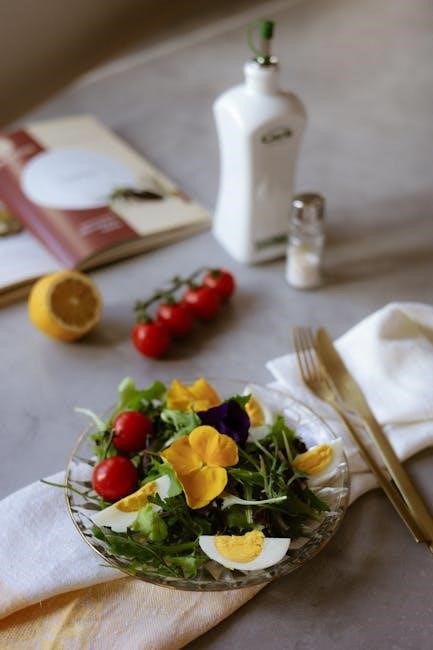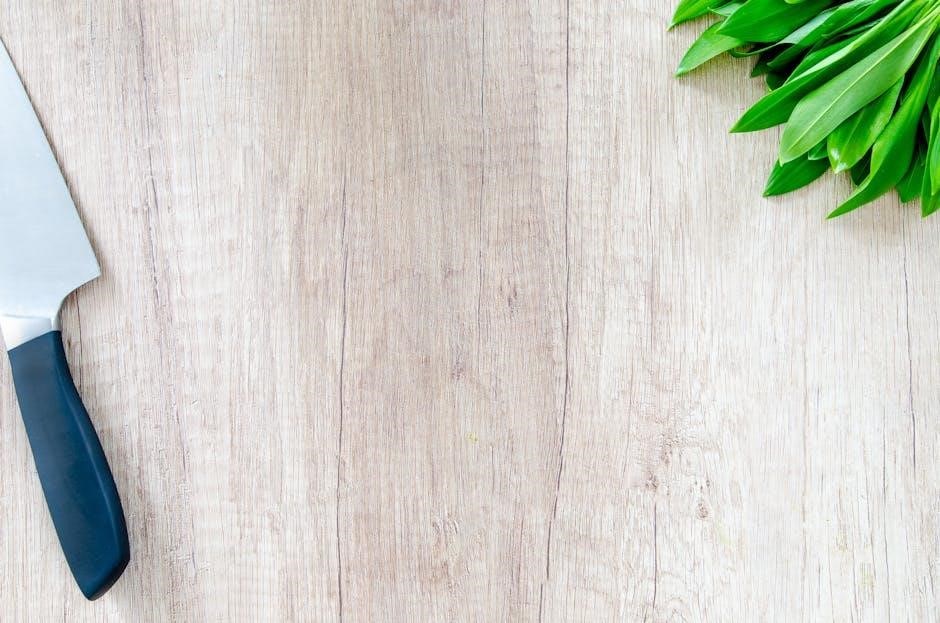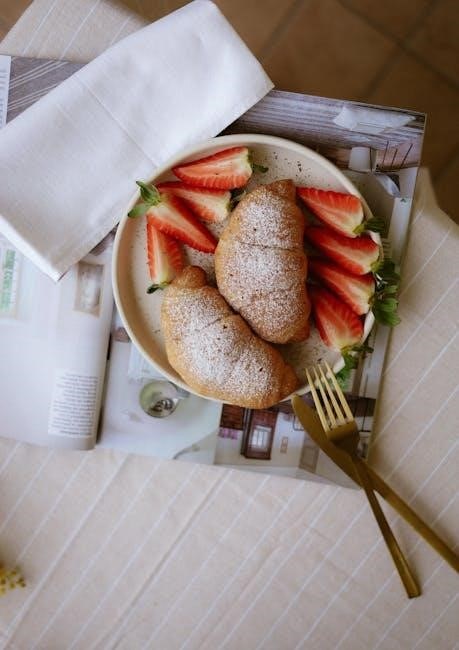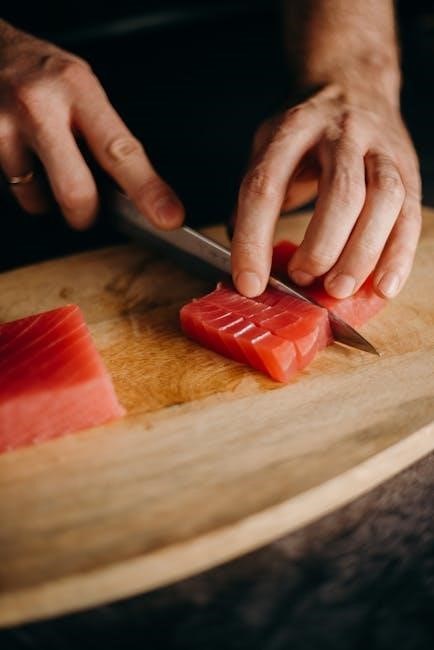A kitchen knife is an essential tool‚ blending craftsmanship and functionality. This guide explores the art of selecting‚ maintaining‚ and sharpening your knives for optimal performance in the kitchen.
1.1 Importance of a Good Kitchen Knife
A good kitchen knife is essential for precision‚ control‚ and efficiency in cooking. It ensures clean cuts‚ reduces food waste‚ and makes preparation safer and faster. A sharp‚ well-balanced knife elevates the cooking experience‚ allowing for consistent results and reducing fatigue during repetitive tasks. Investing in quality enhances both the process and the joy of cooking.
1.2 Brief History of Kitchen Knives
Kitchen knives have evolved from ancient stone tools to sophisticated instruments. Early knives used flint or bone‚ while later designs featured bronze and iron. The Middle Ages saw the rise of Damascus steel‚ prized for its strength and sharpness. Modern knives often combine stainless steel with ergonomic designs‚ reflecting centuries of innovation aimed at enhancing functionality and user comfort.
Choosing the Right Kitchen Knife
Selecting the right knife involves considering blade material‚ edge style‚ and handle comfort. Prioritize sharpness‚ durability‚ and ergonomics to match your cooking needs and preferences effectively.
2.1 Factors to Consider When Selecting a Knife
When selecting a knife‚ consider blade material‚ edge style‚ and handle comfort. Think about your cooking habits‚ the types of food you prepare‚ and the knife’s durability. Sharpness‚ ease of maintenance‚ and ergonomic design are also crucial. Choose a knife that feels balanced in your hand and suits your skill level for optimal performance in the kitchen.
2.2 Understanding Blade Materials and Quality
Blade materials vary in durability‚ sharpness‚ and maintenance needs. Stainless steel is durable and resistant to rust but may lack sharpness. Carbon steel is sharper but requires more care to prevent rust. High-carbon stainless steel offers a balance of durability and sharpness. Damascus steel is prized for its aesthetic pattern and edge retention. Choosing the right material depends on your cooking style and maintenance preferences.
2.3 Handle Design and Comfort
A comfortable handle is crucial for precise control and reduced fatigue. Materials like wood‚ metal‚ or composite offer durability and grip. Ergonomic designs ensure a natural fit in the hand‚ while contoured shapes minimize strain. A well-designed handle enhances balance‚ making cutting tasks more efficient and enjoyable. Prioritize handles that align with your grip style and cooking techniques for optimal comfort.

Parts of a Kitchen Knife
A kitchen knife consists of the blade‚ edge‚ spine‚ and handle. The blade performs the cutting‚ while the edge determines sharpness. The spine adds strength‚ and the handle ensures control and balance.
3.1 Blade Anatomy
The blade is the primary cutting component of a kitchen knife‚ featuring a straight or curved edge. Its shape and tip determine functionality‚ with pointed tips for precision and rounded tips for safety. The blade’s material‚ such as high-carbon stainless steel‚ ensures durability and sharpness. Its thickness affects versatility‚ balancing precision and strength;
3.2 Edge Styles and Their Uses
Edge styles determine a knife’s cutting efficiency. The V-edge is most common‚ offering sharpness for slicing and chopping; A chisel edge is ideal for tasks like filleting and precision cuts. Straight edges provide smooth‚ clean cuts‚ while serrated edges excel at cutting tough textures like bread. Each style is designed for specific kitchen tasks‚ ensuring versatility in food preparation.

Sharpening and Maintenance
Sharpening and maintenance are crucial for prolonging knife life. Regular honing and using sharpening stones maintain edge quality. Proper care ensures safety and optimal performance in the kitchen.
4.1 How to Sharpen a Knife
Sharpening a knife involves using sharpening stones to refine the edge. Start with a coarse grit stone to shape the blade‚ then progress to finer grits for polishing. Maintain the knife’s angle throughout the process. Light‚ consistent strokes ensure an even edge. Test the sharpness by slicing paper; a sharp knife should cut cleanly. Finish by honing with a steel to align the edge for optimal performance.
4.2 Honing vs. Sharpening: What’s the Difference?
Sharpening removes metal to create a new edge‚ while honing aligns and refines the existing edge without removing material. Sharpening is done with stones and is necessary when the knife is dull. Honing‚ using a steel‚ maintains edge alignment and sharpness between sharpening sessions. Both processes are essential for maintaining knife performance‚ but they serve distinct purposes in edge care.
Care and Maintenance Tips
Regular honing and sharpening are vital to maintain knife performance. Use sharpening stones consistently to keep edges sharp and aligned‚ ensuring optimal cutting efficiency and blade longevity always.
5.1 Storing Knives Properly
Proper knife storage is crucial for safety and longevity. Use a knife block‚ magnetic strip‚ or sheaths to protect blades. Avoid storing knives in damp environments or with other utensils‚ as this can cause rust or damage. Store them in a dry place to maintain edge quality and prevent accidents in the kitchen.
5.2 Cleaning and Avoiding Rust
Regularly clean your knife with mild soap and warm water‚ avoiding abrasive cleaners or bleach. Dry thoroughly‚ especially between the blade and handle‚ to prevent rust. Store in a dry place and apply a thin layer of food-safe oil to the blade. Avoid exposure to acidic foods for extended periods‚ as they can damage the finish and promote rust formation.
Handling and Safety
Proper knife handling ensures safety and efficiency. Always cut away from your body‚ maintain a firm grip‚ and avoid common mistakes to prevent accidents and injuries.
6.1 Safe Cutting Techniques
Mastering safe cutting techniques is crucial for preventing accidents. Always keep your fingers curled under and out of the blade’s path‚ use a stable cutting board‚ and maintain a firm grip on the knife. Cut away from your body and never apply excessive pressure. These practices ensure precision and safety while working with sharp kitchen knives.
6.2 Avoiding Common Mistakes
- Avoid using excessive force‚ as it can lead to slips and accidents.
- Never store knives loosely in drawers‚ as this increases the risk of injury.
- Don’t use the wrong knife for a task‚ as it can damage the blade or hinder performance.
- Keep fingers away from the blade’s edge and maintain control while cutting.

Common Types of Kitchen Knives
From chef’s knives to serrated knives‚ each type serves specific purposes in food preparation. Understanding their unique designs and uses ensures efficiency and precision in the kitchen.
7.1 Chef’s Knife
The chef’s knife is a versatile tool‚ often called the workhorse of the kitchen. Its straight or slightly curved edge allows for efficient chopping‚ slicing‚ and mincing. Blades typically range from 6 to 12 inches‚ with ergonomic handles designed for comfort and balance. This knife excels at handling various ingredients‚ making it indispensable for both professional chefs and home cooks alike.
7.2 Paring Knife
The paring knife is a small‚ versatile tool essential for peeling‚ trimming‚ and coring fruits and vegetables. Its compact design allows for precision and control‚ making it ideal for detailed kitchen tasks. The sharp edge ensures clean cuts‚ while the ergonomic handle provides comfort and maneuverability. Crafted from high-quality materials‚ it’s a must-have for both home cooks and professional chefs‚ enhancing overall food preparation.
7.3 Serrated Knife
The serrated knife‚ often called a bread knife‚ features a toothed edge designed for slicing through tough exteriors like bread crusts or tomatoes. Its unique edge style minimizes tearing‚ ensuring clean cuts. Ideal for delicate foods‚ it’s crafted from durable materials and designed for comfort. Regular honing maintains its sharpness‚ making it a versatile tool for both everyday and specialized culinary tasks.

Upkeeping Edge Quality
Maintaining a knife’s edge quality requires regular sharpening and honing to ensure consistent performance. Using sharpening stones and proper techniques prevents dulling and extends the knife’s lifespan.
8.1 Using Sharpening Stones
Sharpening stones are essential for maintaining a knife’s edge. Start with a coarse grit to repair dull edges‚ then progress to finer grits for polishing. Hold the knife at the correct angle and stroke the stone smoothly. Regular use ensures a razor-sharp edge and extends the knife’s lifespan. Always clean the stone after use for optimal performance;
8.2 Maintaining Edge Consistency
Regular sharpening and honing are key to maintaining a consistent edge; Avoid cutting on hard surfaces or metal‚ as this can dull the blade quickly. Store knives properly to prevent accidental damage. Consistency in maintenance ensures your knife remains sharp and reliable‚ enhancing your cooking experience over time.
A good kitchen knife is more than a tool—it’s a partner in culinary creativity. As knives evolve with technology‚ mastering their care ensures timeless utility and precision.
9.1 Final Tips for Getting the Most Out of Your Knife
Regular sharpening and honing are key to maintaining edge quality. Store knives properly to prevent damage and rust. Avoid cutting on hard surfaces and use the right knife for the task. Clean and dry your knife after use to ensure longevity. With proper care‚ your knife will remain a reliable companion in the kitchen.
9.2 The Future of Kitchen Knives
The future of kitchen knives is poised for innovation‚ with advancements in materials and technology. High-performance steels and ergonomic designs are expected to dominate‚ enhancing durability and comfort. Smart knives with sensors for edge maintenance could emerge‚ offering users greater convenience. These developments will cater to both home cooks and professionals‚ ensuring kitchen knives remain indispensable tools for years to come.